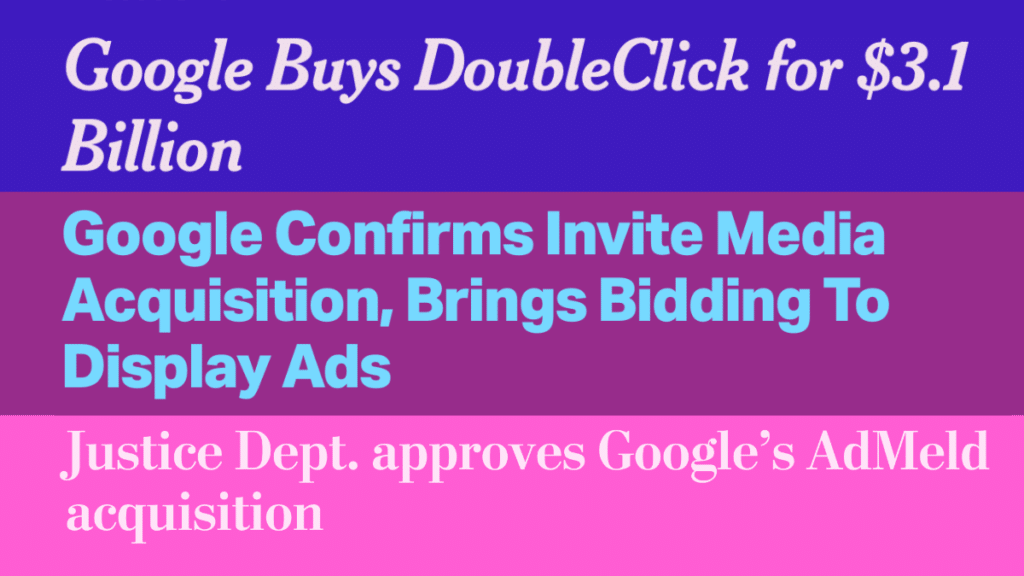How Three Mergers Buttressed Google’s Ad Tech Monopoly, Per DOJ
Karina Montoya / Mar 9, 2023Karina Montoya is a journalist with a background in business, finance, and technology reporting for U.S. and South American media. She researches and reports on broad media competition issues and data privacy at the Center for Journalism & Liberty, a program of the Open Markets Institute, in Washington, D.C.

When the Department of Justice brought an antitrust case against Google for monopolization of digital advertising technologies (known as “ad tech”) earlier this year, most of the media attention fell on DOJ’s ask to break up Google’s advertising unit. Indeed, that fact by itself is deserving of attention, as it makes this antitrust case potentially the most far-reaching since the breakup of AT&T in the early 1980s.
Yet, to understand why DOJ’s request to break up Google was not done lightly, it is worthwhile to analyze the lawsuit’s insights about Google’s key acquisitions in this market, and how they enabled the tech giant to entrench its control over the technologies that serve web publishers, including small news organizations, in the company’s bid to meet advertisers’ demand across the web.
Three deals — the purchases of DoubleClick, Invite Media, and AdMeld — “set the stage” for the tech giant to “control and manipulate” the selling and buying of digital ads, says DOJ. Amid similar investigations by competition agencies in Europe (one still ongoing), DOJ is the first antitrust enforcer globally to make the allegation that not one, but three of Google’s acquisitions have contributed to business behavior that violates current U.S. antitrust law.
As described in a previous article, publishers and advertisers use three main ad tech products to place ads: publisher ad servers (for publishers to manage their ad spaces), ad buying tools (for advertisers to buy ads), and ad exchanges, where supply and demand meet. Before they were purchased, DoubleClick, Invite Media, and AdMeld acted in each of these segments as Google’s competitors.
Today, after merging all these companies into Google’s own ad tech stack, the tech giant owns the ad exchange AdX, the publisher ad server Google Ad Manager, and two ad buying tools, DV360 (which serves large advertisers) and Google Ads (for smaller advertisers). In each of these product segments, Google’s market share measured by revenues ranges from 40 to 90 percent, DOJ revealed in the suit.
DOJ depicts Google’s dominance in each product market of the ad tech stack that connects publishers with advertisers. Source.
What did these companies do exactly? And what type of antitrust scrutiny did the deals face at the time when they were announced?
DoubleClick: How It All Began
In the early 2000s, Google’s primary business was to sell ads on its own search engine through Google Ads. Since those same advertisers wanted to buy ads on websites other than Google’s search results, the company started offering that service as well. For Google to meet this new demand, though, it needed to connect Google Ads with publishers already working with other ad servers.
By the mid-2000s, many ad tech providers acted as publisher ad servers. Google recognized that it was the publisher ad servers who set the rules for how and to whom ad spaces are sold, DOJ states. Thus, Google developed its own publisher ad server. But after unsuccessfully trying to get its new product to gain traction, in 2008 Google closed its acquisition of the top competitor in that market segment: DoubleClick.
By merging DoubleClick into Google’s nascent publisher ad server, the newly merged company captured a 60 percent share of that product market (measured by revenue). Most importantly, as part of this deal Google also acquired the ad exchange technology that came with DoubleClick, which would turn into today’s AdX. Because of the acquisition of AdX alongside DoubleClick, DOJ argues, “Google positioned itself to function simultaneously as buyer, seller, and auctioneer” of digital ads.
The deal, valued at $3 billion, has received by far the most media coverage out of the three deals described by DOJ as anticompetitive. One reason is that it was immediately controversial, precisely due to antitrust concerns. The Federal Trade Commission cleared the deal, but not by unanimous vote. Then-Commissioner Pamela Harbor warned in December 2007 that the merger would lessen competition and consumer protections related to privacy.
Search data gathered by Google and browsing data collected by DoubleClick would converge to enable “highly targeted advertising” and turn the newly merged company into a “super-intermediator with unparalleled access to data sources,” Harbor wrote. Her warnings became reality. Today, per DOJ, the publisher ad server Google Ad Manager and the ad exchange AdX, which wouldn’t have existed without DoubleClick, have market shares of 90 percent and 50 percent, respectively.
Invite Media: Capturing More Large Advertisers
Acquired by Google in 2010 for about $81 million, Invite Media was an ad buying tool designed for large advertisers. Essentially, these advertisers used it to buy ad space on multiple ad networks at the same time. Thus, instead of buying ad space on the publishers’ ad inventory that Google and Yahoo each managed separately, large advertisers would use Invite Media to compare ad prices as they posted on both platforms in real time.
That was an important feature that large advertisers sought, as they usually worked with advertising agencies that managed big budgets and wanted more control to negotiate ad prices and where they appeared. At the time, Google was developing its DV360 tool to serve that same market. Eventually, Google merged Invite Media with DV360 and gained access to a much larger network of advertisers, which “complemented Google Ads and expanded Google’s control over advertiser demand,” says DOJ.
From the beginning, this deal sparked concern among ad agencies, ad tech providers, and analysts. A particularly sharp Gartner analyst questioned whether Google, which already was the largest seller of digital ads on search, could “continue to provide both media and the platforms for trading media in a neutral way.” After the deal, Tech Crunch reported how this so-called “integration of ad tech” was creating such a black box of intermediaries that advertisers wouldn’t even know their money was going to Google.
In 2020, Google and Invite Media made the news again in a Bloomberg report about how Invite Media trimmed its assets just to the right level to dodge the Federal Trade Commission’s pre-merger review. The report revealed how ad tech companies feared competition from Google in 2010 — a time when Google made only a tenth of the revenues it makes today. Michael Provenzano, one of Invite Media’s co-founders, said to Bloomberg that had the company stayed in the race, it would have most likely not survived Google’s buying spree. “Why go through that battle?,” Provenzano said.
Today, DV360 is the largest platform for agencies and big advertisers with a 40 percent market share, while Google Ads, used mostly by small brands, has an 80 percent market share, per DOJ. Because of Google’s dominance in ad spend made by small and large advertisers, publishers were left with little choice but to work with Google, as the tech giant provided preferential access to all that advertising demand to publishers using its publisher ad server, according to DOJ.
AdMeld: Further Entrenching Among Publishers
As Google continued to expand beyond search ads, it acquired AdMeld in 2011 for $400 million. AdMeld was a company that did the same as Invite Media, but for news publishers. AdMeld’s technology helped big publishers compare and identify the best ad prices that advertisers were offering on ad exchanges competing with Google. AdMeld was founded in a particular context, per DOJ: as ad tech companies realized Google was not working in the best interest of publishers, they started offering a new type of service to connect news publishers with more ad exchanges.
Media coverage of the deal touted how companies like AdMeld allowed publishers like Thomson Reuters or News Corp to access different ad prices from several ad exchanges that connected to several advertisers outside of Google’s ad network. This new functionality was a threat to Google because it forced Google’s ad exchange to compete against a greater number of market players, and it reduced Google’s control of both sides of the ad sale, according to DOJ.
After acquiring this company, Google repeated the recipe it used for DoubleClick and Invite Media: it merged AdMeld’s network of publishers with its own. At first, Google said that AdMeld’s publishers would continue to connect with other ad exchanges. But it eventually shut down AdMeld’s operations with competing ad exchanges and prohibited publishers connecting to AdX from using any other platform that would force AdX to compete for the best ad prices, DOJ explains.
The lawsuit cites, for the first time, an email by a Google product manager describing the company’s strategy then, and how Google allegedly knew this would hurt publishers. “Our goal should be all or nothing – use AdX as your [exchange] or don’t get access to our [advertising] demand,” the suit reads. If DOJ’s allegations are proven in court, it would demonstrate how, in hindsight, publishers were right to distrust Google since the deal was announced, as Digiday’s Brian Morrissey reported back in 2011.
The deal was cleared by the DOJ under the Obama administration. At that time, Google’s market share of ad sales on third-party websites was still lagging behind Facebook and Yahoo, and this would have helped sway the DOJ to clear the merger, the Seattle Times reported. But as the understanding of the ad tech market has evolved, if DOJ’s allegations are proven right under current U.S. antitrust law, it would revive the historical antitrust approach that market share isn’t necessarily the main factor in analyzing how anticompetitive conduct takes place.
It may take at least two years for this lawsuit to make it to a jury trial, as requested by DOJ. If all the government’s allegations survive to that stage, this may be the first time that the American public will access first-hand knowledge of how this invisible ad tech market monetizes their personal data, how Google came to dominate this landscape with an unfettered power that transformed news organizations, individual web creators, and our very thinking about online privacy.
Authors
